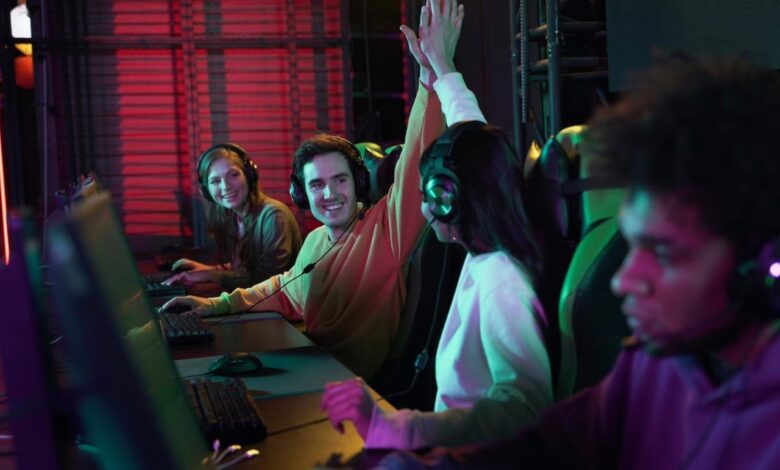Building A Thriving Gaming Community From Scratch

Building a gaming community isn’t just about gathering players; it’s about cultivating a thriving ecosystem where individuals share a common passion, find belonging, and forge lasting connections. In the digital age, where countless games and platforms vie for attention, a strong, vibrant community is the most powerful tool for longevity and success. It transforms a simple pastime into a meaningful social experience, creating a loyal following that will stick with you through new game releases, content changes, and the ever-evolving landscape of gaming. This comprehensive guide will walk you through the essential strategies, from laying the groundwork to fostering sustained growth, to help you build a community that doesn’t just survive but flourishes.
The Foundation of Your Community’s Purpose

Before you invite a single person, you must first define the heart and soul of your community. This crucial first step dictates every decision that follows, from the platforms you choose to the content you create.
A. Discovering Your Niche
The gaming world is vast and diverse. Trying to appeal to everyone is a surefire way to appeal to no one. Instead, identify a specific niche that you are passionate about. This could be a single game, a genre, a playstyle, or even a specific philosophy. For instance, are you building a community around a competitive esports title like Valorant or League of Legends? Or is your focus on a cozy, cooperative game like Stardew Valley? Perhaps it’s not the game itself but the type of players—speedrunners, lore enthusiasts, or modders. Specificity is key because it allows you to attract the right people and provide them with exactly what they’re looking for.
B. Identifying and Understanding Your Target Audience
Once you have a niche, delve deep into understanding the people who inhabit it. What are their motivations? What kind of content do they consume? What are their pain points and what excites them? Are they casual gamers who want a relaxed space to chat, or are they dedicated players seeking to improve their skills and find teammates? Knowing your audience’s demographics, interests, and habits will enable you to tailor your content, communication style, and community events to their needs, making them feel seen and valued from the moment they join.
C. Establishing Core Values and Community Guidelines
A strong community is built on a foundation of shared values. What is your community’s identity? Is it a positive, family-friendly space, or is it a more adult, no-holds-barred environment? Whatever you decide, these values must be translated into clear, concise, and non-negotiable community guidelines. These rules are your social contract—they protect members from harassment, prevent toxicity, and ensure a positive experience for everyone. Post them prominently and enforce them consistently. Consistency in rule enforcement builds trust and demonstrates that you take the community’s well-being seriously.
Choosing Your Platforms for Engagement
The platform you choose serves as the digital home for your community. It’s where interactions happen, and memories are made. Each platform offers unique features and caters to different community needs.
A. Discord
For most gaming communities, Discord is the undisputed central hub. Its versatility allows for text channels, voice chat, and video calls, making it perfect for real-time communication. To build a powerful Discord server, you must organize it logically. Create specific channels for different topics, such as game discussion, off-topic chat, community announcements, and looking-for-group (LFG) channels. Use roles to segment your members—giving them titles based on their activity, game proficiency, or specific interests. Incorporate bots to automate tasks, moderate content, and add fun features like polls or mini-games. A well-organized Discord server feels like a bustling, living space rather than a chaotic chat room.
B. Twitch and YouTube
Live streaming platforms like Twitch and YouTube are more than just places to broadcast gameplay; they are powerful community-building tools. Your streams and videos are the front door to your community, attracting new members and keeping existing ones engaged. Interacting with your chat is paramount—call out viewers by name, answer their questions, and make them feel like a part of the action. Running viewer games, where your community members can join you in-game, is a fantastic way to deepen relationships. YouTube, with its emphasis on evergreen content and long-term discoverability, complements Twitch perfectly. Use both platforms to cast a wide net and direct your viewers back to your central community hub, like a Discord server.
C. Social Media
Social media platforms like Twitter, Instagram, and Facebook Groups serve as powerful broadcast channels. Use them to announce new content, share community highlights, and promote events. They act as a billboard for your community, attracting new members who might not have found you otherwise. Sharing clips, memes, and community-generated content on these platforms is a great way to show off the personality of your community and make people want to be a part of it. A dedicated Facebook Group can also act as a mini-forum, fostering discussions and a sense of shared identity.
D. Dedicated Forums and Websites
While less common today, a dedicated community forum or website offers a level of control and ownership that other platforms don’t. This can be a great option for communities built around specific games that require extensive guides, lore discussions, or modding. A website can also be a valuable source of AdSense revenue by hosting long-form articles, game guides, and news. A self-hosted forum gives you complete control over its features, rules, and branding, creating a permanent home for your community’s knowledge base and history.
Fueling the Community Engine

A community needs fuel to thrive, and that fuel is content. Consistent, engaging content gives people a reason to return and participate.
A. Developing a Content Calendar
A strategic content calendar is your roadmap. Plan your live streams, video uploads, and community events in advance. This ensures a steady stream of content, preventing lulls in activity and giving your members something to look forward to. Mix up your content—don’t just stream gameplay. Include variety such as Q&A sessions, game reviews, community spotlights, and collaborative projects. A diverse content schedule keeps things fresh and appeals to different segments of your audience.
B. Live Streaming and Video Creation
Your own live streams and videos are the primary draw. They are your brand and the content that will attract new members. Focus on high-quality production, but don’t let a lack of professional equipment hold you back. Authenticity and passion are far more important. Talk about the game, share your thoughts, and, most importantly, engage with your viewers. For YouTube, focus on creating videos that provide value, such as tutorials, in-depth analysis, or highlights. These videos have a longer shelf life and can bring in new members long after they are published.
C. Encouraging User-Generated Content
Nothing fosters a sense of ownership more than empowering your members to contribute. Encourage them to share their own fan art, highlight clips, game screenshots, and stories. Create dedicated channels for user-generated content and regularly feature the best submissions on your social media or in your streams. This not only provides you with a source of new content but also makes your members feel like an integral part of the community’s success.
D. Community Events and Tournaments
Regularly hosting community events is a powerful way to boost engagement and create shared experiences. Organize tournaments with prizes, run casual “play with the community” nights, or set up a collaborative creative project. The goal is to give members a reason to log on and interact with each other beyond a simple chat. These events create memorable moments that strengthen bonds and encourage a sense of camaraderie.
The Art of Engagement
A community isn’t just a place to hang out; it’s a place to connect. Active engagement is what transforms a group of passive onlookers into a thriving, interactive network.
A. Welcoming New Members and Making Them Feel at Home
First impressions matter. When a new member joins your community, make a concerted effort to welcome them. A simple “hello and welcome!” in a dedicated channel can make a huge difference. Create a welcome channel that explains the server rules, provides a brief introduction to the community, and asks new members to introduce themselves. This small gesture shows that you value them and sets the stage for a positive experience.
B. Encouraging Conversation and Discussion
As a community leader, you set the tone. Ask open-ended questions in your chat, start a discussion about a new game or an update, and participate in conversations initiated by others. Show genuine interest in what your members have to say. Don’t be afraid to share your own experiences and thoughts—vulnerability and authenticity are powerful tools for building rapport.
C. Recognizing and Rewarding Active Members
Recognizing your most dedicated members can significantly boost morale and loyalty. This could be as simple as giving them a special role in your Discord, a shout-out on your stream, or a mention on social media. Acknowledging their contributions makes them feel valued and encourages others to become more involved. Active participation is a reward in itself, but a little public recognition goes a long way.
D. The Power of Polls and Community-Driven Decisions
Give your community a voice. Use polls to let them vote on what game you should stream next, what kind of events you should host, or even what a new channel should be named. This sense of ownership makes members feel invested in the community’s future and shows them that their opinions matter. Community-driven decisions lead to higher engagement and a more democratic, resilient community.
Cultivating a Positive Culture
A healthy community requires careful stewardship. Without proper moderation and leadership, even the most promising community can quickly devolve into a toxic environment.
A. The Vital Role of Moderators
Your moderators are the guardians of your community. They are on the front lines, enforcing rules, answering questions, and de-escalating conflicts. Choose your mods carefully—they should be active members you trust, who understand the community’s values, and who can handle difficult situations with maturity and fairness. Empower them with the tools they need and support them in their decisions.
B. Handling Conflicts and Negative Behavior with a Clear Process
Toxicity and conflict are inevitable in any online community. The key is to have a clear, consistent process for handling them. Don’t engage in public spats. Take the conversation to a private channel and address the issue directly, calmly, and without emotion. Always refer to your community guidelines and be prepared to take action, whether it’s a warning, a temporary ban, or a permanent removal. The goal is not to punish but to protect the community.
C. Leading by Example
As the community leader, your behavior sets the standard. Your actions, words, and attitude have a ripple effect. Be a positive, welcoming, and fair presence. Show passion for your community and the game you play, and lead with empathy. If you foster a culture of kindness and respect, your members are more likely to emulate that behavior.
Growth Strategies
Once you have a solid community foundation, you can begin to focus on growth. The goal is to attract new members who will enrich the community and help it grow organically.
A. Cross-Promotion and Collaboration
Partnering with other content creators or community leaders in your niche is one of the most effective ways to grow. A collaboration exposes your community to a new audience that already shares a similar interest. Reach out to creators with a similar size or slightly larger audience and propose a joint stream, a tournament, or a content project. It’s a win-win for both parties and a great way to bring fresh faces into your community.
B. Running Giveaways and Contests
Giveaways are a powerful tool for attracting attention and generating buzz. Offer an enticing prize—a new game, in-game currency, or gaming peripherals—and use it as a way to get people to join your community or follow you on social media. While a giveaway might bring in a flood of temporary members, a well-run contest can attract engaged participants. For example, a contest for the best game clip or fan art submission encourages creative participation and helps you find dedicated members.
C. Leveraging SEO and Content Marketing
For those building a website or forum, Search Engine Optimization (SEO) is paramount for organic growth. Create long-form, valuable content around your niche. Write comprehensive guides, reviews, and news articles that answer common questions people ask on search engines. Use relevant keywords naturally throughout the text and optimize your images and headings. High-quality, SEO-optimized content acts as a passive funnel, bringing in new members 24/7 who are actively searching for what you offer. This is where Google AdSense revenue begins to accumulate, as your content attracts a steady stream of traffic.
Conclusion
Building a successful gaming community is a marathon, not a sprint. It’s a continuous journey that requires patience, dedication, and a genuine passion for the people you’re building it for. The process begins with a clear vision and a well-defined niche, but its true power lies in the human element—the countless small, authentic interactions that happen every day.
The ultimate reward of building a community isn’t just about reaching a certain number of members or monetizing your content. It’s about creating a safe, welcoming, and supportive space where people can be themselves, celebrate their shared passion, and form friendships that transcend the digital realm. A thriving community becomes a place where people find a sense of belonging, a place they can call home. It becomes a testament to the idea that video games are more than just a source of entertainment; they are a catalyst for connection and a powerful force for good.
Remember, the goal is not to have the biggest community, but the best community—one filled with engaged, loyal, and positive members. Your authenticity and persistence are your greatest assets. Celebrate the small victories, learn from the setbacks, and always put your community members first. By focusing on fostering genuine relationships and providing consistent value, you will create a legacy far more meaningful than any number on a screen.



